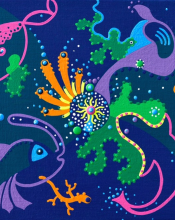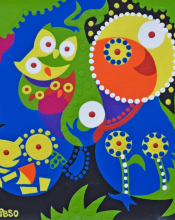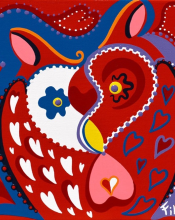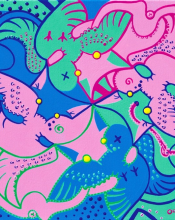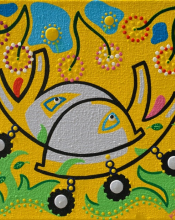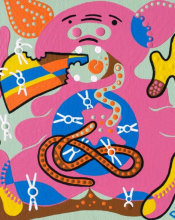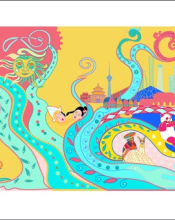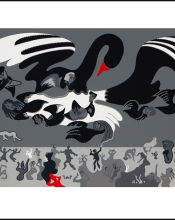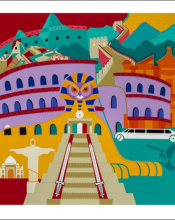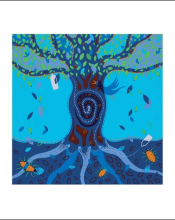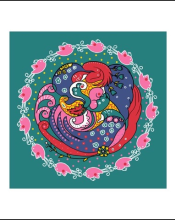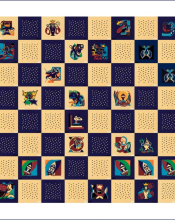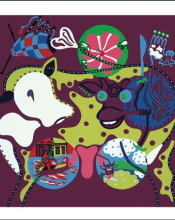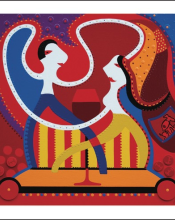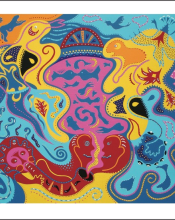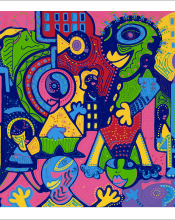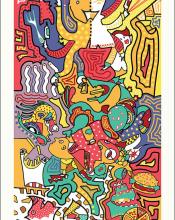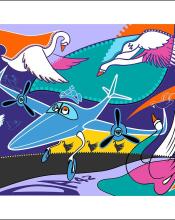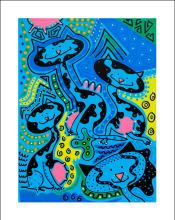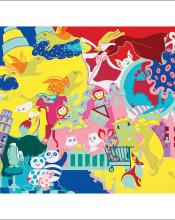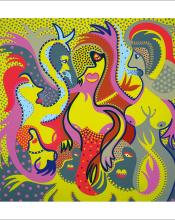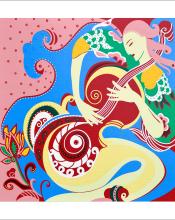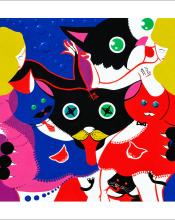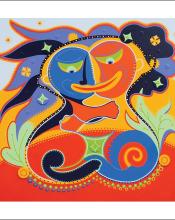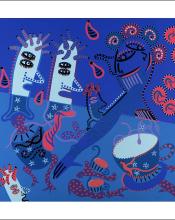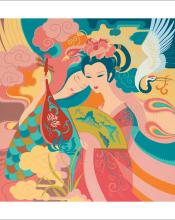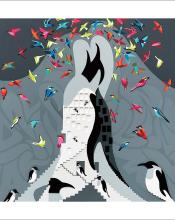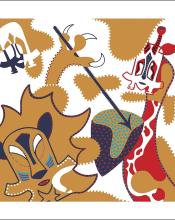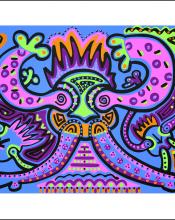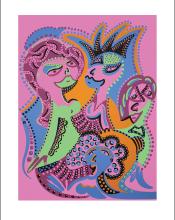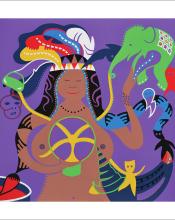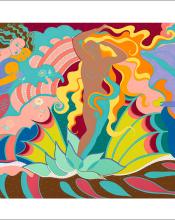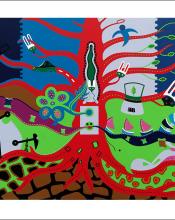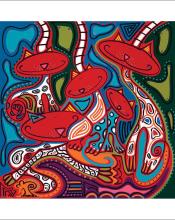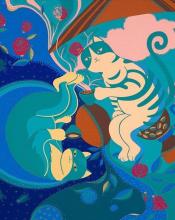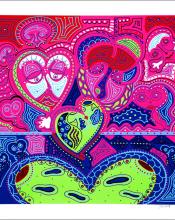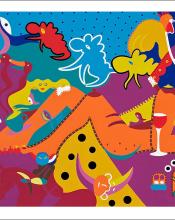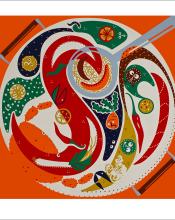Toyism Behind the Mask 面具背后的玩具主义
In the world of art, one is constantly seeking to experiment with innovative techniques and styles in a cycle of excitement and disappointment. Art has always been a process of deconstruction and reconstruction, similar to a child’s sand castle on a beach being repeatedly torn down and built back. The main purpose for an art movement is to attack the one before and start an art riot that can save the art world. The entire history of art can be seen as a series of reaction and counter-reaction. At times, movements are programmed to oppose one another.
This is certainly not the case with Toyism, a mysterious but vigorous art movement founded by artist Dejo in 1992 in the Netherlands. It is a contemporary art movement trying to rediscover the meaning of painting without the intent to overthrow postmodernism. This is the one thing that makes Toyism a stand-alone movement.
Toyism is an art movement with its own grammar characterized by vibrant colors and imaginative, often surreal, representations and stories. The Toyism movement is ambiguous. While other movements emphasize the importance of rejecting, Toyism focuses on embracing instead. Some art movements exhibit at only museums and galleries; others say that all worthy art must be in the streets. Toyism accepts both. Those who have never entered a gallery or a museum can see Toyism works in the streets and say: “Finally, art for the people!”; those who are solely gallery or museum goer’s can see Toyism works and say “Behold, this is art!”. Some might ask if the use of shapes in Toyism is influenced by graffiti or street art, but at the same time they must also question why there are beautiful animal lines in the Lascaux cave paintings. Is their fluidity not similar to the Toyism lines? Others might ask if Toyism is somewhat rooted in Surrealism in terms of mimicking the world of dreams that reveal hidden psychological mechanisms.
There is no doubt that Toyism can be considered surrealist themed. The characteristic of Toyism is that it can adopt everything, as long as it can be translated into Toyism’s visual language. Toyism produces powerful and delicate art based on a secret manifesto called “Mother” about its ‘I Play Therefore I Am’ art and philosophy. There is nothing in it about the role of the art in the contemporary society, nor anything that can be considered a programed slogan. This pioneer manifesto is not used as a publicity stunt. It is about playing, dreaming, and everything else one can imagine.
What is Toyism in short?
Toyism emphasizes simplicity, craftsmanship and consistent colours and strong designs.
Toyism is easy viewing at first, no eye-popping colour vibration, but underneath every artwork there is a story to discover. Eyes are drawn to the allegory - keep looking and you find (or not) additional meaning in the graphic code.
Toyism is a friendly, uplifting oasis in a world that increasingly focuses on the bizarre, the violent and the freak.
Toyism’s artists and its manifesto are not about something dark, narrow, twisted, or tortured, but about life and light.
在艺术的世界里,一个人在兴奋和失望的循环中,不断地的在实践中寻求创新的技巧和风格。艺术一直是一个解构和重建的过程,就像一个孩子在海滩上的沙堡被反复拆除和重建。一场艺术运动的主要目的是否定旧形式,发动一场可以拯救艺术界的艺术革命。整个艺术史可以看作是一系列的颠覆和反颠覆。有时,运动被设定为相互对立。
玩具主义(Toyism) 当然不是这种情况。1992年,荷兰艺术家德奥 (Dejo) 发起了一场神秘但充满活力的艺术运动。它是一场试图重新发现绘画意义的当代艺术运动,并没有推翻后现代主义的意图。这是玩具主义成为一个独立运动的原因之一。
玩具主义是一种艺术运动,具有自己的语法,其特点是鲜艳的色彩和富有想象力,通常是具有超现实的表现和故事性。玩具主义运动是模棱两可的。其他运动强调否定的重要性,而玩具主义则强调接纳。一些艺术运动只在博物馆和画廊展出;还有人说,所有有价值的艺术都必须在街头。玩具主义两者都接受。从未进过画廊或博物馆的人,可以在街头看到玩具主义的作品,感叹:“终于,艺术为人民服务了!”那些只去画廊或博物馆的人可以看到玩具主义的作品,并说:“看,这是艺术!”有些人可能会问,玩具主义中形状的使用是否受到涂鸦或街头艺术的影响,但与此同时,他们也必须质疑,为什么拉斯科洞穴壁画中有美丽的动物线条。它们的流动性与玩具主义线条不相似吗?其他人可能会问,玩具主义是否在某种程度上植根于超现实主义,因为它模仿了揭示隐藏心理机制的梦的世界。毫无疑问,玩具主义可以被认为是超现实主义主题。玩具主义的特点是,只要能翻译成玩具主义的视觉语言,它什么都可以采用。玩具主义基于一个名为“母亲”的秘密宣言,即“我玩故我在”的艺术和哲学,创造出强大而精致的艺术。其中没有任何关于艺术在当代社会中的角色,也没有任何可以被认为是纲领性口号的东西。这个先锋宣言并不是用来做宣传噱头的。它是关于玩耍、梦想,以及人们能想象到的一切。
简而言之,玩具主义是什么?
玩具主义强调简单、匠人精神、一致的色彩和强烈的设计。
玩具主义一开始很容易看,没有令人瞠目的色彩震动,但在每件艺术品的背后都有一个故事等待被发现。
眼睛被寓言所吸引——继续看,你会在图形代码中发现(或没有)额外的含义。玩具主义是一个友好的、令人振奋的绿洲,在这个世界上,越来越多的人关注怪异、暴力和惊悚。它的艺术家和宣言不是关于黑暗、狭隘、扭曲、折磨的东西,而是关于生命和光明的。

